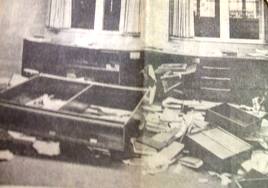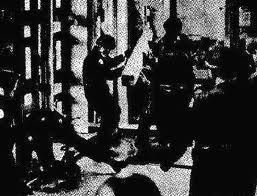The Stanford Medical Center Protest: Looking for Trouble
For those groups that had long been
kept down in American society, the 1960s were a decade of rising expectations. The political and legal successes of African-Americans in
the civil rights movement showed the way for many other groups long
repressed --- women, the poor, Latinos. These groups watched as African-
Americans laid out a blueprint for how to achieve real social
change. But the civil rights movement also raised expectations to a
level that was unattainable in such a short time. In the cities where Third
World poverty continued despite promises for change, dreams were
deferred and violence erupted.
As historian Anatol Rapoport explained,
“It is not the people without hope who feel themselves most frustrated…but people who made some headway, who are led to expect more,
and whose hopes have been disappointed.” As it happened, the
headway made by African-Americans in the early 1960s led to the riots and explosions seen in the inner-cities in the late ‘60s.
It
also resulted in higher expectations among all those who suffered injustice. As
Dr. King had said, “The time is now” and it seemed that every group
with a grievance --- real or not --- suddenly came forth to demand
their rights. Many of these groups had more than reasonable complaints, but the
mainstream establishment could only handle so many rebellions at one
time. Indeed, for the half of America that had
thrived during the
1950s, the next decade seemed to be spinning horribly out of control. And by
the early 1970s, students and leftists were looking for new causes
to pursue.
This was the scene as students and leftist activists focused
on a small but real inequity at Stanford University Medical Center
--- the salary of the custodians. The condition of the working poor was the
sort of issue that galvanized students and baffled the
establishment. While students saw it as a good place to think globally and act locally, hospital administrators were caught off guard
by the sudden and unexpected outrage.
The controversy began when
custodian Sam Bridges was fired in late March of 1971. Bridges had been trying to organize custodians at the hospital and discussing the merits
of Black Power. His dismissal led to condemnation among civil
rights and student groups on campus. On April 8th, 1971, 250 protesters marched to the office of hospital director Dr. Thomas Gonda to further
press demands. Finding him out to lunch, 60 of the protesters
decided to stage an overnight sit-in, occupying administration offices between
the hospital’s surgical clinic and blood bank. The activists
included members of campus groups and outsiders, including the Black
United Front, the Black Liberation Front, Venceremos and the Latin Alliance. Demands were listed that encompassed both
the Bridges firing as well as another perceived injustice at the hospital --- the refusal to grant tenure to Latino doctor Jose
Aguilar.
The next day as negotiations stalled at the sit-in’s 30 hour
mark, Stanford officials called the Palo Alto Police Department.
Arriving in riot gear, some 70 Palo Alto cops and nearly 100 sheriff deputies
congregated outside the hospital offices along with impartial
observers and local press. At 5:55 PM, Assistant Police Chief
Clarence Anderson declared the sit-in to be an “unlawful assembly” and gave the
protesters five minutes to disperse. When they did not, the police
prepared to forcefully clear the area.
What followed was a violent and
chaotic melee. Using a long timber as a battering ram, four police officers rushed at the barricaded office, smashing through the glass door,
exposing the metal frame. While the police charged, protesters used
all available means to fight back. One protester hurled a tape dispenser at policeman Jack Garner, knocking him out cold. Other demonstrators
managed to turn a hose on the officers, pushing them back with a
barrage of rushing water. Two policemen countered by spraying chemical mace from aerosol cans through the now open doorway.
Meanwhile, officers inquired into cutting the protesters’ water
supply, but found that this would also cut water to patients throughout the
hospital.
Thirty-five minutes into what was degenerating into an
increasingly riotous free-for-all, the police changed tactics.
Using a bolt cutter, they attached ropes to the hinges of an office door and
yanked it from its frame. Then shouting “let’s get ‘em,” PAPD
officers stormed the doorway as most demonstrators fled for a back entrance. But officers guarding that east side exit were left
undermanned. Protesters met just a half dozen policemen there and
engaged them by wildly swinging clubs made of detached furniture legs with sharp
metal edges and screws. Police Chief Jim Zurcher later said that some of his men
could see nothing but “demonstrators coming at them with clubs.”
All told, the injury count in the end stood at 13 police and a couple dozen protesters --- many of whom were wheeled down the hall to
the hospital emergency room.
The damage to Medical Center property was
also extensive ---some $100,000 in damages. The Palo Alto Times
described the scene the next day: “The floor was covered with water and littered
with broken glass, furniture stuffing and books and papers.
Telephones and typewriters were smashed as were pencil sharpeners
and glass coffee makers.” Harry Press of the University News Service called it
“absolute
devastation.” And small eruptions of violence continued
into the night as youths threw rocks at police cars and buses, 5
bomb threats were called in and three fire bombs were thrown at the campus
electrical station.
Both the police and protesters condemned one another.
Chief Zurcher, who later would become known for his sensitivity to
the merits of civil protest, called the Stanford Hospital assault, “the most
vicious and unprovoked attack on police I have ever seen.”
Meanwhile, the Black Students Union denounced the “brutal tactics
employed by Stanford University against peaceful demonstrators.”
In
truth, it was not a shining day for either side. While demonstrators may have
been fighting for the welfare of a group in need of assistance,
their tactics were violently aggressive. The police also contributed to the disorder by storming the sit-in with a battering ram rather than further attempting to defuse the conflict.
The fall-out from the April 9th
incident lingered throughout 1971. Protests and demonstrations continued as activists and students increased their demands to rehire Sam Bridges
while pursuing more peaceful demonstrations such as a hospital
worker “sick-in” and a brief employee strike.
Shortly after the conflict,
Palo Alto police officers ransacked the offices of the Stanford Daily newspaper, attempting to recover photographs that might help convict
protesters. The Daily sued and the resulting court case, Zurcher vs. Stanford Daily would eventually go all the way to
the Supreme Court.
Meanwhile, the trials of protesters in the April 9th
incident would also make headlines throughout 1971 as 6 protesters
were charged with felony assault and battery and 18 others faced misdemeanors.
And protests began anew on June 21st when Stanford fired 5 of the
workers who were involved in the April 9th incident. This led to
100 students and workers marching outside Personnel Director Robert Nelson’s office for nearly an hour. Two weeks later a pipe bomb exploded outside
Nelson’s house nearly injuring his
teenage
daughter.
Eventually, Bridges would lose his appeal to the National Labor
Relations Board and the controversy would finally simmer. Most of
the protesters would plead guilty to reduced or suspended sentences and the Palo Alto Police Department would set upon a less aggressive policy in
negotiating with protesters. But for that three or four year period
in the late ‘60s and early ‘70s, Palo Alto was continually rocked by riots,
protests and marches. Indeed, as the rising expectations of those
out of power clashed with the defensive posture of those with power,
such conflicts seemed nearly inevitable. []
Our Reader's Memories:
Be the First!
Send Us Your Memory!
Jim Zurcher was the new police chief in Palo Alto during the crisis. (PAHA)

Damages at the Medical Center after the riot.

A rather fuzzy photo of the police using a battering ram to break into the barricaded office.